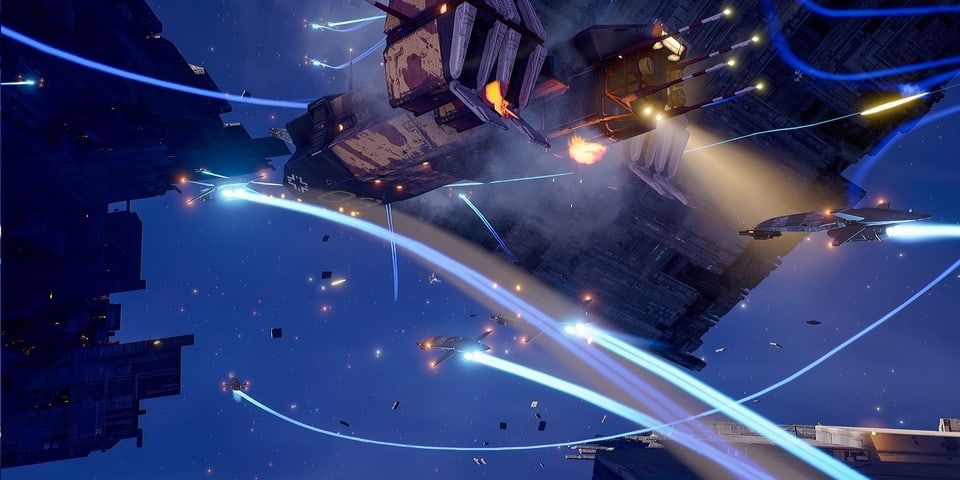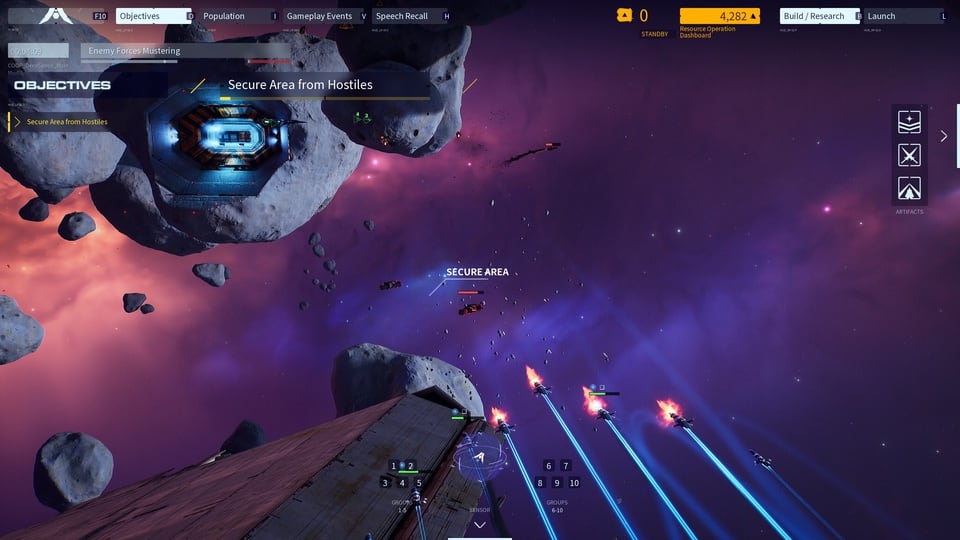The wait for a third Homeworld game has finally come to an end. The pioneering 3D space RTS was a brilliant sun flare of excellence at the turn of the millennium, but faded into an almost mythological status amidst acquisitions, IP purchases and more. After a two decades wait, Homeworld 3 is ready for launch.
Homeworld remains one of the outright coolest strategy games I can think of, though that admittedly comes from a relatively juvenile male perspective on space and military actions, real and imagined – this game series lives in the same pantheon as the 2000s Battlestar Galactica’s most action-packed episodes. The crackle of unit comms, the professional and controlled tone of voice, the design of the ships and the cinematic mass fleet actions were excellent in 1999 and that same tone and style persists through to Homeworld 3.
It’s around a century on from the events of Homeworld 2, with the Hiigarans the presiding empire in the galaxy and an age of abundance thanks to the Hyperspace Gate Network, but all is not well. There’s the looming threat of The Anomaly, and Karan S’Jet’s expeditionary fleet disappeared decades ago. When massive planet destroying attacks hit a number of planets on the fringes of the Anomaly’s territory, a new fleet is launched with Karan’s granddaughter Imogen plugging herself into the new Mothership and overcoming her initial doubts and fears, teaming up with the steady Isaac Paktu (Ike Amadi) as the fleet’s Intel officer – he honestly has exactly the right voice for this role.
It’s another desperate journey across the galaxy, facing another unknown and daunting enemy in a retread of the arcs from the first two games, but Homeworld 3 puts a lot more personality into the tale than before. In contrast to the cool and detached nature of the fleet combat, this aims to be a more personal story, putting these characters before you through lavishly rendered cutscenes between missions. Doing that, though, leans very heavily into a messianic story arc for Imogen and the S’Jet family as a whole.

There’s a good flow of mission styles through the campaign. Starting off under pressure and on the run, you rebuild your military strength, start to strike back against the Incarnate and force a final battle against the Incarnate seat of power. Through this there’s missions big and small, there’s a defensive battle to hold a line almost like it’s a tower defence mission, a stealthier mission where discretion is the best path to follow, an epic confrontation with a whole shipyard that challenges you from multiple directions, and more.
Each and every mission here leans into the megalith structures that are the big new feature for Homeworld 3. Where earlier games were almost exclusively in the open void of space, level scenery is a constant in Homeworld 3, whether it’s vast Progenitor constructs or sometimes inexplicable natural formations. It helps bring some great set dressing to each level, providing some new tactical options and challenges in the process, as objects can provide cover for both stealth and avoiding damage, which units in certain modes will use on approach, and tunnels are often placed to provide covert flanking routes – important to use to get the drop on enemy Frigates and Capital Ships that have much less armour at the rear. That said, having such massive structures leads to some levels feeling very constrained and directed, which is a strange feeling for a space game.
This also puts greater demands on unit pathfinding and the controls for issuing commands, and the game doesn’t quite hit the mark here, as units feel sluggish to respond and commands a bit inconsistent. The contextual right click isn’t wholly predictable in whether it will bring up the move disc (which you can bring up with ‘V’) or direct units to a piece of scenery, and I was forever blighted by mis-clicks, because holding right click enables camera rotation. Obviously you can work around this, but it’s a bit of an annoyance. For the diehard series fans there’s options for Modern, Legacy and blended controls, with full rebinding of keys.

Then there’s the difficulty I felt in setting effective command groups or pinpointing specific units to give commands to. Units are overlaid with class-specific icons, and you can get a cleaner understanding with the Sensor view, but in the middle of battle it all descends into a bit of mush. On standard difficulty I split my fleet in two at most, once I had a secondary carrier that could support production elsewhere, and would largely just select all and do an attack box. The unit abilities are much simplified and more direct, focussing on special attacks and stat buffs as opposed to tactical support for a group, so I’d just break those out to target the highest priority enemy being thrown my direction.
One of the real saving graces here is the tactical pause and adjustable game speed – with 25%, 50%, 75% and 100% – which really helps with managing your fleet during the campaign… though obviously isn’t an option online. You don’t get proper feedback for commands issued at full pause until you resume, so 25% is often the best option if you’re under pressure.

Alongside the story campaign, you naturally have skirmish mode against AI and support for online multiplayer, but there’s also War Games, a roguelite mode that can be played in short one hour burst with up to three players.
Each run takes you through three stages, the first two of which give you different missions like retrieving power cores, trying to rescue civilian ships, and the like, before a final grand encounter with multiple firm objectives and a climactic encounter with a capital ship. Through this you can retrieve artefacts that let you pick from ship-boosting perks, feeding into an overarching progression that unlocks different fleet styles to choose from.
It’s generally a fine mode, and a good compliment to co-op skirmishes against AI, but the focus is rather narrowed by only having a small subset of ships to play with. The intention here, of course, is that you pick complimentary fleets in co-op and focus on particular frigates, helping you deal with the greater challenges provided by higher difficulties. A standard run might take around an hour, but as you ramp up the difficulty, gruelling battles might take longer.
Disappointingly, we saw some connectivity hiccups while playing for review – though this was ahead of the day one update. Our partner (who was actually hosting) got disconnected right before the final fight, and they ended up with nothing for their time and efforts. The game migrated over to me, giving control of both fleets all of a sudden. Hopefully this issue can be resolved by the launch update or shortly afterwards, along with further improved pathfinding and other snags. Blackbird was able to make good changes between the War Games demo in February and launch, and there’s a year-long plan for post-launch content updates with new maps, challenges, and paid DLC factions.




